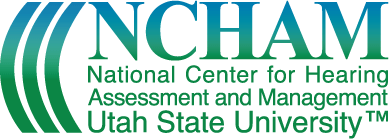Get to Know EHDI and Hands & Voices
Get started by learning how early hearing detection and intervention (EHDI) programs and Hands & Voices work at the national level and in your own state.
Early Hearing Detection and Intervention (EHDI)
The goal of EHDI is to ensure that infants who are deaf or hard of hearing are identified as early as possible and begin to receive appropriate intervention by 6 months of age. EHDI programs have demonstrated both the feasibility and benefits of universal newborn hearing screening. The average age of diagnosis and referral has steadily decreased since they began (Joint Committee on Hearing, 2019).
Other key elements of EHDI include (NCHAM, n.d.):
- Family support and partnerships, including access to culturally-competent information
- A medical home for every child by 3 months of age
- Data management systems to keep track of patients through screening, diagnosis, and referral processes
EHDI collaborates with the American Academy of Pediatrics (AAP). Almost every AAP chapter has an EHDI Chapter Champion who serves as the point person on newborn hearing issues at state and local levels (AAP, n.d.) and the AAP has developed a position statement outlining principles and guidelines for EHDI programs.
If you don't already have someone on your project who has expertise with EHDI, these resources can help you learn about its laws, regulations, processes, and procedures at both the federal and state level.
Resources
General Information
Early Hearing Detection and Intervention System
National Goals and Program Objectives For the EHDI Tracking and Surveillance System
Early Hearing Detection and Intervention (EHDI) Program Chapter Champion
State-Specific Information
State-by-State Universal Newborn Hearing Screening Legislation
Hands & Voices
Hands & Voices is a non-profit, parent-driven organization dedicated to supporting families of children who are deaf or hard of hearing. They are "non-biased about communication methodologies and believe that families can make the best choices for their child if they have access to good information and support" (Hands & Voices, n.d.). One of their activities is to partner with EHDI programs to support and include families in EHDI initiatives and services.
Hands & Voices has local chapters throughout the country. Each has a range of services that vary depending on local funding and staffing. Not all programs are the same, but they have the same mission of parent-to-parent support. In addition to Hands & Voices, there are other family-based organizations that partner with EHDI.
Hands & Voices has a family support program called Guide By Your Side (GBYS) that may provide opportunities to reach families of infants who are deaf-blind but are unaware of your state deaf-blind project. GBYS has parents who are specially trained to serve as guides for families who have just learned of their child's hearing condition and are in need of support from someone who has walked the same path (Hands & Voices, 2018).
References
American Academy of Pediatrics. (n.d.). Early hearing detection and intervention (EHDI) program chapter champion job description.
Hands & Voices. (n.d.). Information about Hands & Voices.
Hands & Voices. (2018). Hands & Voices guide by your side frequently asked questions and guiding principles.
Joint Committee on Infant Hearing. (2019). Year 2019 position statement: Principles and guidelines for early hearing detection and intervention programs. Journal of Early Hearing Detection and Intervention, 4(2), 1-44.
NCHAM (National Center for Hearing Assessment and Management). (n.d.) Early hearing detection and intervention systems.

